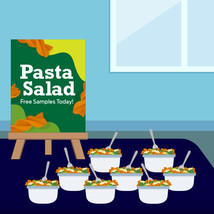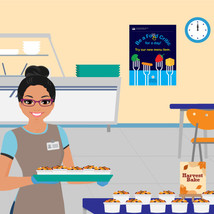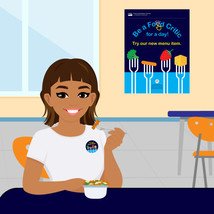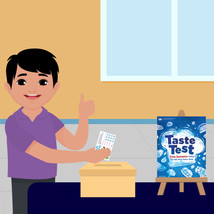|
Having trouble viewing this email? View it as a Web page.
|
|
|
|
Ingredients for a Successful Taste-Test Event
Taste tests are a great way for school nutrition professionals to introduce new menu items and get students excited to try healthy foods at school. The input collected from students can be used to improve recipes and create school meals that students want to eat. Use the tips below to help plan and host a successful taste-test event.

1. A Yummy Recipe or Food to Taste
Choose a recipe or food that you are considering adding to your school meals menus. Taste testing is a key part of the Institute of Child Nutrition’s USDA Recipe Standardization Guide and the best way to measure student acceptability. Some schools fund student taste-testing events using money from the school food service account, while others use grant funds, such as Team Nutrition Training Grants. When preparing the sampling area, provide utensils, napkins, and water. Both before and during the event, share (with staff, students, families) the taste-test recipe, nutrition and food allergen information, and highlight any locally produced ingredients in the recipe.
|

2. A Prime Location
Choose a location that will not disrupt the flow of meal service. Some schools put a taste-testing table near the cafeteria entrance, others provide taste-test samples on the serving line or use a mobile cart to carry samples from table to table. If you want to target a specific grade or smaller group, use a smaller location like a classroom, so you can gather more in-depth feedback.
|

3. Student Engagement
Get students excited about participating in the taste test before and during the event. Promote the event several days in advance with signage, decorations, and morning announcements. Check out Team Nutrition’s taste-test event materials including posters, stickers, and social media graphics. Take this opportunity to educate and empower students. Team Nutrition’s student article, How School Lunch is Made, demonstrates how taste tests give students "a voice" in school meal menu development, so foods are both delicious and nutritious. The Minneapolis Public School District has found success in engaging student leaders to serve samples at their taste-test events.
|

4. Simple Ballots
The process for voting and providing feedback works best when it is simple and age-appropriate. Students can provide feedback with paper or electronic ballots, posters with stickers, or ballot boxes. As part of the 2021 Team Nutrition Training Grants for School Meal Recipe Development, the Wisconsin Department of Public Instruction developed a taste-test ballot for middle and high school students to provide constructive feedback. The ballot allowed students to select specific characteristics that describe the taste and texture of the recipe, such as “spicy” or “creamy”. This provided school nutrition professionals with useful information to make specific modifications to recipes, tailoring them more towards students’ preferences.
|

5. A Food Safety Plan
Food safety is the responsibility of every person in school nutrition programs. State or local health department requirements must be followed when serving food, including during taste-test events. Prevent foodborne illness by ensuring that anyone who prepares or handles food must first wash their hands and use gloves, as required. Make sure the sampling area is washed and sanitized before and after the event. Follow time and temperature control guidelines for hot and cold prepared food. Follow your school’s food allergy management plans and practices.
|

6. After Taste-Test Action
The best way to get support for future taste tests and for school meals is by sharing taste-test findings and how they will be used to improve school meal programs. Gather the ballots, document student feedback, and keep all taste-test results with your recipe records. Continue the excitement by posting the results in the cafeteria. Make sure to communicate with everyone, from administration to students, by letting them know that their vote matters, and when the recipe will be featured on the school menu. Use marketing strategies when adding the new item to the menu. This can include having students vote on the name of the new menu item or serving it on a special day.
|
Find more resources to celebrate National School Lunch Week at https://www.fns.usda.gov/tn/school-lunch-resources.
|
|
|
|
|
|
|